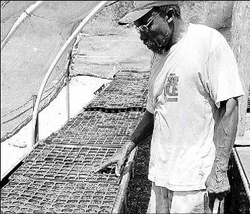
In this 2008 file photo, farmer Lloyd Payne inside his greenhouse where he grows lettuce, celery and cauliflower. - File
With significant losses in agriculture due to adverse weather conditions every year in Jamaica, farming with greenhouses is one way to safeguard plants and increase harvests.
Those interested in greenhouse technology can receive training by signing up for the modified environment agriculture certification programme at the Ebony Park HEART Academy in Clarendon.
The Academy, in collaboration with the Ministry of Agriculture, the Rural Agricultural Development Authority (RADA) and USAID's Jamaica Farmers Access to Regional Markets (JA FARMS) project launched this programme in July 2008.
The certification programme aims to train Jamaicans in greenhouse fabrication and protected agriculture horticultural practices.
You will learn about the plant-growing environment, plant nutrition and fertilisation, integrated pest management and crop culture.
Contact information
The training programme is free. To get in on the programme, contact the Ebony Park HEART Academy, or to know more about greenhouse farming, touch base with the Greenhouse division of the Ministry of Agriculture in Kingston.
The Ministry of Agriculture has already begun introducing local farmers to low-cost greenhouse construction.
The model it has developed costs approximately $10,000 to build including labour, materials and drip irrigation - compared with imported greenhouses that can cost $30,000 or more.
These low-cost greenhouses are 600 square metres in size and are constructed of lumber, wire, and plastic.
Drip irrigation systems are required and many have netting to keep out insects.
Users of the low-cost system in Jamaica have experienced improved harvests including, in several cases, nine pounds of tomatoes per plant, compared to three to four pounds from open-field operations.
It is noted that plant and fruit quality is better and post-harvest losses are significantly lower when using the greenhouse. For tomato farmers, the harvest in the low-cost greenhouse of this size could be 1,500 plants per crop cycle. Many farmers are now growing year-round to achieve even higher incomes.
avia.ustanny@gleanerjm,.com